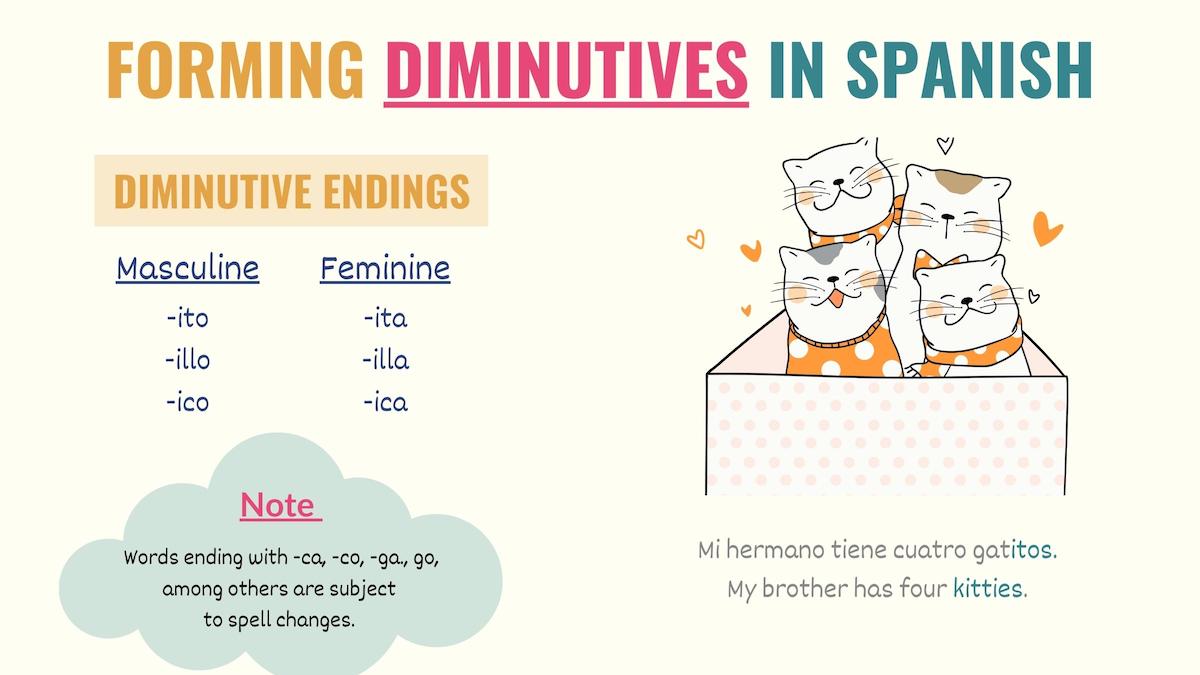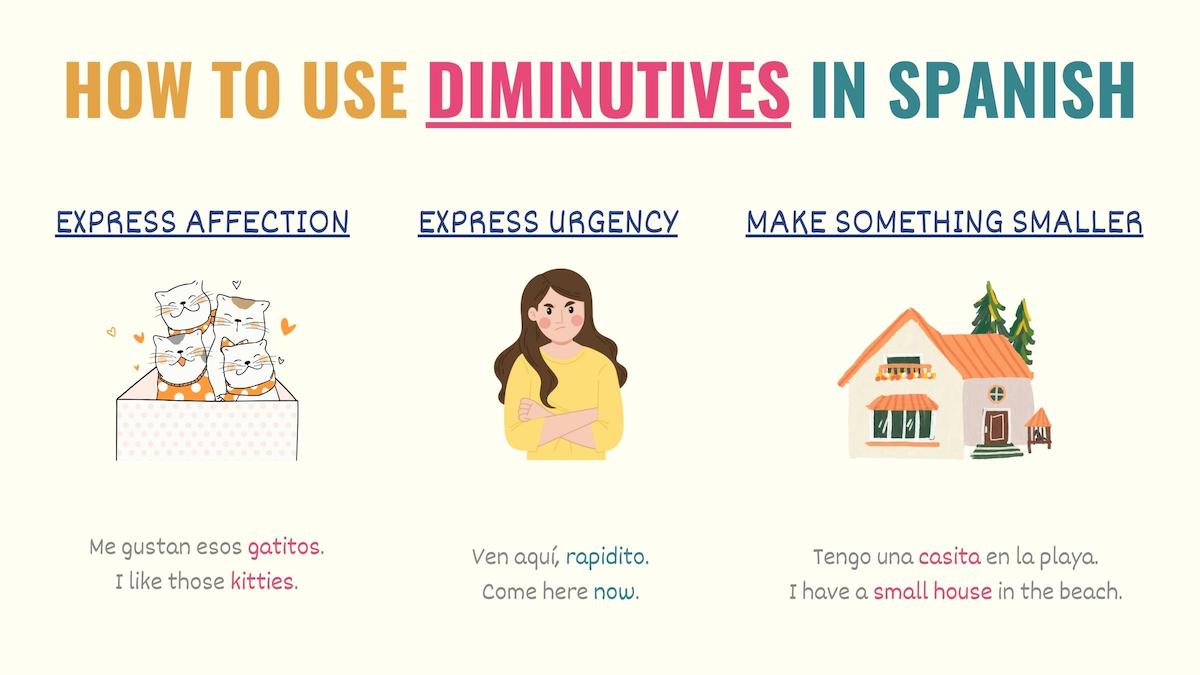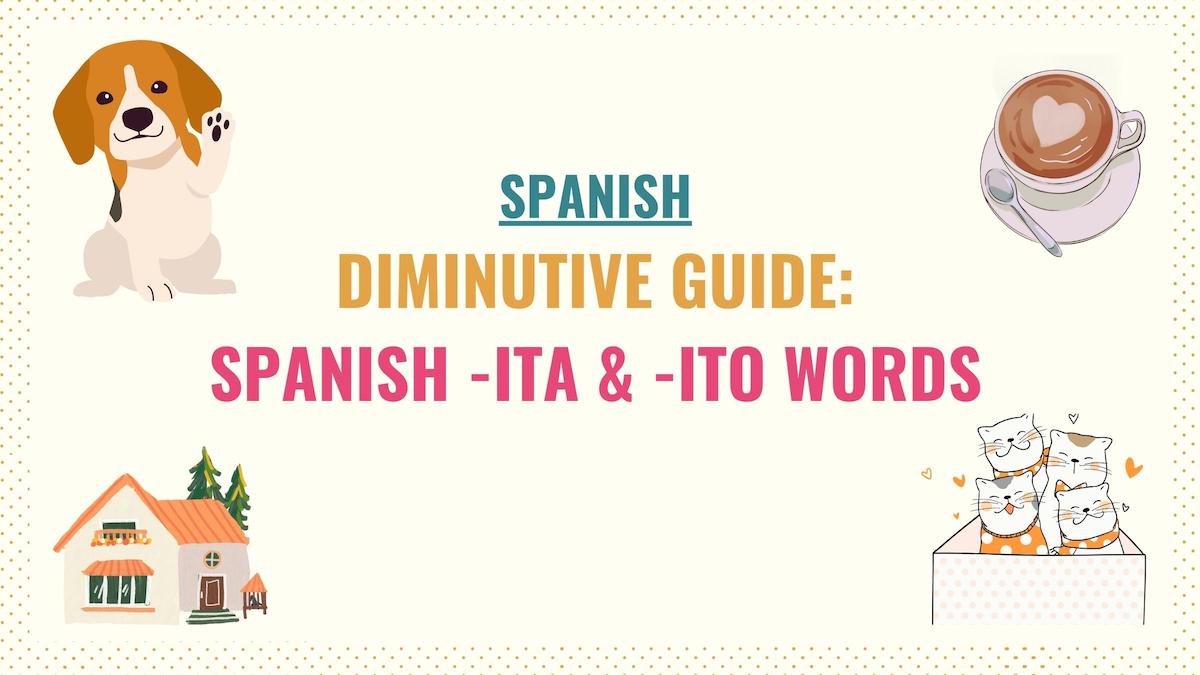Diminutive forms are extremely common in conversational Spanish. So much so that learning how to use these words correctly will help you sound more natural when speaking Spanish.
Because this topic is crucial, here is what you’ll learn in this guide to diminutives:
- Endings to Form a Diminutive in Spanish
- When & How to Use Diminutives
- Bonus: Augmentative Words
- Key Points
- Downloadable PDF
- Additional Resources
I’ve included examples with common nouns and adjectives so you understand how to form diminutive words. Let’s do this.
How to Form Diminutives: Spanish Suffixes
In a nutshell, diminutives are formed by adding certain suffixes (word endings for non-grammar geeks) to a Spanish noun or adjective. Depending on the word, you may also need to remove the last letter before adding these endings.
In Spanish, the diminutive suffixes are:
- -ito / -ita
- -illo / -illa
- -ico / -ica
These endings are in the singular form. If you’re working with a plural noun, add an s to pluralize these suffixes (-itos, -itas).

Take Note: –ito and -ita in Spanish are the most common diminutive endings, whereas -illo and -illa are slightly less common. On the other hand, the suffixes -ico and -ica are only used in certain types of Spanish dialects, such as Cuban.
Spanish -ito and -ita endings
Ita and ito in Spanish are used with nouns ending in -o, -e, -a, or a consonant. However, you should know that certain diminutives have spelling changes to keep their pronunciation consistent.
When a noun in Spanish ends with -o, -e, or -a, you must delete these vowels and add -ito and -ita (or other diminutive suffixes). For example:
- Casa: Casita
- Oso: Osito
- Perro: Perrito
- Mano: Manita
- Chocolate: Cholatito
- Laura: Laurita
Take Note: When using diminutive forms, you must keep in mind the gender of a noun. For example, even though mano ending with an ‘o’, it’s actually a feminine noun. As a result, we must use the –ita, which is a feminine suffix.
With nouns that end in a consonant, you must simply add -ito and -ita to the end of the word:
- Papel: Papelito
- Árbol: Arbolito
- Reloj: Relojito
These rules are also applicable to the other set of diminutive endings. Here are some examples of how to use these words in a sentence:
Me gusta ese perrito.
I like that little dog.
Es un carrito muy bueno.
It’s a nice little car.
Hay unos problemillas en la oficina.
There is some trouble in the office.
Niños, ¿quieren una paletica?
Kids, do you want a popsicle?
Take Note: For the most part, a diminutive in Spanish may be translated as ‘little’ or ‘small’. However, these words may sometimes convey a different meaning than English diminutives.
Spelling changes with diminutives
As explained above, -ito and –ita are Spanish’s most common diminutive suffixes. However, we must make spelling changes with some nouns to maintain the pronunciation or orthography rules. These changes consist of adding a consonant to the diminutive endings.
1. Words ending in -co or –ca must use the suffix -quito or -quita:
- Barco: Barquito
- Blanco: Blanquito
- Muñeca: Muñequita
- Vaca: Vaquita
2. Words ending in –go or –ga use the ending –guito or -guita:
- Jugo: Juguito
- Mango: Manguito
- Tortuga: Tortuguita
Take Note: The letter g in Spanish has a soft pronunciation when followed by ‘a’, ‘o’, or ‘u’, whereas it produces a hard sound if followed by ‘e’ or ‘i’. We use the suffix -guito or -guita when making diminutive words to keep the soft sound.
3. Single syllable words ending with a consonant use the suffix -ecito or -ecita
- Pan: Panecito
- Tren: Trenecito
- Sol: Solecito
- Pez: Pececito
- Luz: Lucecita
Take Note: In Spanish, we replace the letter ‘z’ with ‘c’ when the following letter is ‘e’.
4. Add the ending -cito and –cita to words ending with the consonants -r or -n
- Avión: Avioncito
- Camión: Camioncito
- Doctor: Doctorcito
- Limón: Limoncito
5. Add the ending –cito or –cita to words ending in -é, or single or double syllable nouns ending in –e:
- Café: Cafecito
- Llave: Llavecita
- Pie: Piecito
- Té: Tecito
- Jefe: Jefecito
Take Note: Some nouns that fall into this category can have two diminutive forms. For instance, the diminutive of mamá could be mamita or mamacita. Also, notice that Spanish accent marks drop in the diminutive form.
When & How to Use the Diminutive in Spanish?
Like English diminutives, in Spanish, we use these forms to:
- Express love and affection
Su abuelita es muy linda.
His grandma is very sweet.
Esa perrita es mía.
That doggy is mine.
- Lessen something’s size or importance
Tengo un problemita.
I have a small problem.
Me compré una casita en la playa.
I bought myself a little house on the beach.
These examples do not necessarily relate to the size of the house or the trouble someone has. In these situations, diminutives allow you to reduce something’s importance or severity. In Spanish, we do this to be more polite or avoid concerning someone.
- Express urgency
Estoy ocupado, pero ahorita voy.
I’m busy, but I’ll go right now.
¡Ponte a limpiar tu cuarto ¡Rapidito!
Clean your room! Now!
Take Note: Nouns and adjectives in Spanish are the most common types of words that we transform into diminutives. However, certain Spanish adverbs (manner and time) can also use these forms.

Bonus: Spanish Augmentatives
As its name suggests, Spanish augmentatives are the opposite of a diminutive form. Simply put, we use augmentatives to increase something’s size.
-ote and -ota are the most common augmentative suffixes in Spanish. For example:
Juan tiene una casota.
Juan has a huge house.
Me mordió un perrote negro.
A big black dog bit me.
Similar to diminutives, you must keep some spelling changes in mind when using augmentatives. For example, you must use -zote or –zota with words ending in ‘n’ or ‘é’ and -ezote or –ezota with single-syllable words:
Ya me tomé un cafezote.
I already had a big cup of coffee.
Jared se comió un panezote.
Jared ate a huge piece of bread.
Take Note: There are other endings that you can add to words to express your feelings toward them. For example, -ucho and -ucha are used to refer to nouns in a derogatory way. Casucha conveys the idea of an ugly house.
Key Points
Diminutives in Spanish are commonly used in daily conversations. Here are some key points to remember:
- In Spanish, -ito and -ita (and their plural forms -itos and -itas) are the most common diminutive endings.
- A diminutive is formed by adding -ito and -ita to a word in Spanish.
- Spelling changes are made to maintain or ease the pronunciation.
- The endings –ico and –ica are also diminutive forms in certain types of Spanish.
- A diminutive word is used to express urgency, love, and affection or to reduce the size or importance of something.
- Nouns, adjectives, and certain adverbs can be transformed into diminutives.
Download the Spanish Diminutives Cheat Sheet PDF
Now that you’ve learned how to form Spanish diminutives, you know there are certain rules to follow based on the word you’re trying to change. I’ve created a PDF you can download containing all the key points, rules, examples and graphics for this guide. That way, you can refer back to it any time you want if you need a refresher on forming these words.
Additional Resources: Next Steps on your Spanish Learning Journey
Using -ito or -ita depends on the noun’s gender. Just like not all words ending in ‘o’ or ‘a’ are masculine, not all feminine words end in ‘a’. So, you make sure you know the rules for the gender of nouns in Spanish.
On top of working with nouns, a Spanish diminutive word can also be an adjective. You can also use these rules with all adverbs of manner.



